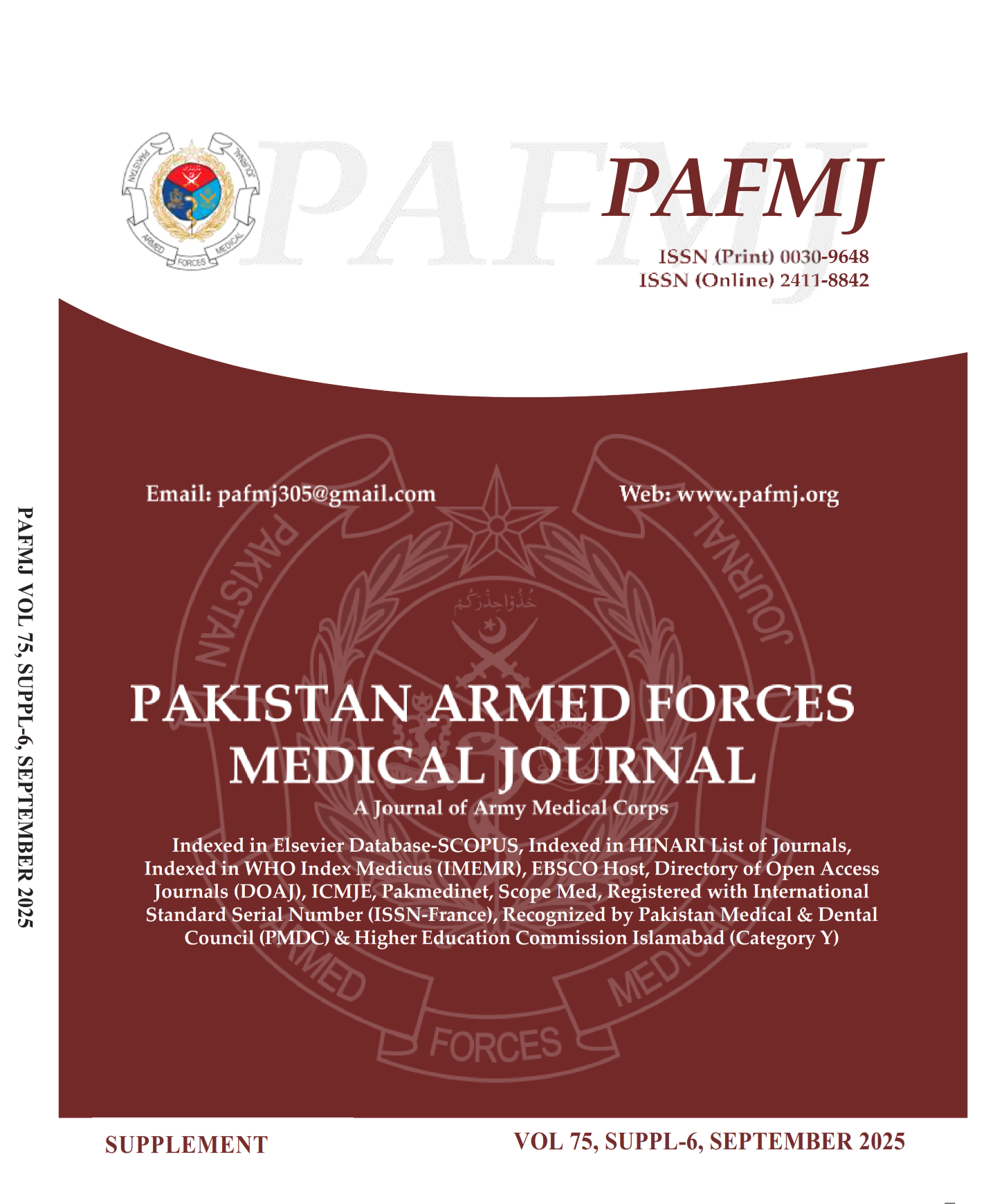Serum Fibrinogen as marker of disease severity in Polymyalgia Rheumatica
DOI:
https://doi.org/10.51253/pafmj.v75iSUPPL-6.4257Keywords:
Fibrinogen, Polymyalgia Rheumatica, severity.Abstract
Objective: To determine the role of serum fibrinogen as marker of disease severity in Polymyalgia Rheumatic.
Study Design: Cross sectional study.
Place and Duration of Study: Rheumatology/General Medicine Department, Pak Emirates Military Hospital, Rawalpindi Pakistan, from Jul 2019 to Feb 2020.
Methodology: Patient of polymyalgia rheumatica who fulfilled diagnostic criteria by European League against Rheumatism (EULAR)/American College of Rheumatology (ACR) published in 2012, for Polymyalgia rheumatica were included in study. fibrinogen levels in serum were determined in all the patients from laboratory of own hospital. Severity of disease was determined on the basis of Polymyalgia rheumatica activity score (PMR-AS) which is used in clinical practice to grade the severity of disease.
Results: Mean age of the study participants was 56.37±3.292 years. 94(39.2%) patients had mild activity disease, 112(46.7%) had moderate while 34(14.2%) had severe activity of illness. 132(55%) had serum fibrinogen levels within normal range while 108(45%) had raised levels of serum fibrinogen. It was revealed that long duration of illness and levels of fibrinogen had a statistically significant association with severity of illness among the patients suffering of polymyalgia rheumatica (p-value <0.05).
Conclusion: Polymyalgia rheumatica is a commonly diagnosed illness in severe forms in the rheumatology/medicine outpatient departments. Raised Serum fibrinogen levels and long duration of polymyalgia rheumatica emerged as strong predictors of presence of severe form of illness among the study participants.
Downloads
References
1. Yates M., Graham K., Watts R.A, MacGregor AJ. The prevalence of giant cell arteritis and polymyalgia rheumatica in a UK primary care population. BMC Musculoskelet Disord 2016; 17(1): 285. https://doi.org/10.1186/s12891-016-1127-3
2. Mohsin Z, Asghar AA, Faiq A, Khalid I, Ul-Haque I, Rehman S et al. Prevalence of Rheumatic Diseases in a Tertiary Care Hospital of Karachi. Cureus 2018; 10(6): e2858.
https://doi.org/10.7759/cureus.2858
3. Milchert M, Brzosko M. Diagnosis of polymyalgia rheumatica usually means a favourable outcome for your patient. Indian J Med Res 2017; 145(5): 593–600.
https://doi.org/10.4103/ijmr.IJMR_298_17
4. Kermani TA, Warrington KJ. Advances and challenges in the diagnosis and treatment of polymyalgia rheumatica. Ther Adv Musculoskelet Dis 2014; 6(1): 8–19.
https://doi.org/10.1177/1759720X13512450
5. Levy JH1, Szlam F, Tanaka KA, Sniecienski RM. Fibrinogen and hemostasis: a primary hemostatic target for the management of acquired bleeding. Anesth Analg 2012; 114(2): 261-274.
https://doi.org/10.1213/ANE.0b013e31822e1853
6. Collen D, Tytgat GN, Claeys H, Piessens R. Metabolism and distribution of fibrinogen. I. Fibrinogen turnover in physiologi-cal conditions in humans. Br. J. Haematol 1972; 22(6): 681-700.
7. McCarthy EM, MacMullan PA, Al-Mudhaffer S, Madigan A, Donnelly S, McCarthy CJ, Molloy ES et al. Plasma fibrinogen is an accurate marker of disease activity in patients with polymyalgia rheumatica. Rheumatology (Oxford) 2013; 52(3): 465-471. https://doi.org/10.1093/rheumatology/kes294.
8. Grau RG, Kassan SS, Franks JJ, Kaplan H, Walker SH, Tan EM. Fibrin(ogen)olysis in polymyalgia rheumatica and temporal arteritis: preliminary findings on association with disease activity. Ann Rheum Dis 1984; 43(5): 721-724.
9. McCarthy EM, MacMullan PA, Al-Mudhaffer S, Madigan A, Donnelly S, McCarthy CJ et al. Plasma fibrinogen along with patient-reported outcome measures enhances management of polymyalgia rheumatica: a prospective study. J Rheumatol 2014; 41(5): 931-937.
https://doi.org/10.3899/jrheum.131055
10. Izumi K, Kuda H, Ushikubo M, Kuwana M, Takeuchi T, Oshima H et al. Tocilizumab is effective against polymyalgia rheumatica: experience in 13 intractable cases. RMD Open 2015; 1(1): e000162.
https://doi.org/10.1136/rmdopen-2015-000162
11. Milchert M, Brzosko M. Diagnosis of polymyalgia rheumatica usually means a favourable outcome for your patient. Indian J Med Res 2017; 145(5): 593–600.
https://doi.org/10.4103/ijmr.IJMR_298_17
12. Leeb BF, Bird HA. A disease activity score for polymyalgia rheumatica. Ann Rheum Dis 2004; 63(10): 1279-1283.
13. Kaur J, Jain A. Fibrinogen. Treasure Island (FL): StatPearls Publishing; 2020 Jan-. Available from:
https://www.ncbi.nlm.nih.gov/books/NBK537184/
14. Manzo C, Milchert M. Polymyalgia rheumatica with normal values of both erythrocyte sedimentation rate and C-reactive protein concentration at the time of diagnosis: a four-point guidance. Reumatologia 2018; 56(1): 1–2.
https://doi.org/10.5114/reum.2018.74740
15. Salvarani C, Boiardi L, Mantovani V, Ranzi A, Cantini F, Olivieri I et al. HLA-DRB1 alleles associated with polymyalgia rheumatica in northern Italy: correlation with disease severity. Ann Rheum Dis 1999; 58(5): 303-308.
16. Mackie SL, Hensor EMA, Haugeberg G, BhaktaB, PeaseCT. Can the prognosis of polymyalgia rheumatica be predicted at disease onset? Results from a 5-year prospective study. Rheumatology 2010; 49(4): 716–722.
17. Brawer AE. Polymyalgia rheumatica: observations of disease evolution without corticosteroid treatment. Open Access Rheumatol 2016; 8: 45–49.
18. Korkmaz C, Yıldız P. Giant cell arteritis, polymyalgia rheumatica, and late-onset rheumatoid arthritis: Can they be components of a single disease process in elderly patients?. Eur J Rheumatol 2017; 4(2): 157–160
Downloads
Published
Issue
Section
License
Copyright (c) 2025 Sohail Raza, Amer Fakhr, Attia Khaliq, Afshan Bibi

This work is licensed under a Creative Commons Attribution-NonCommercial 4.0 International License.















